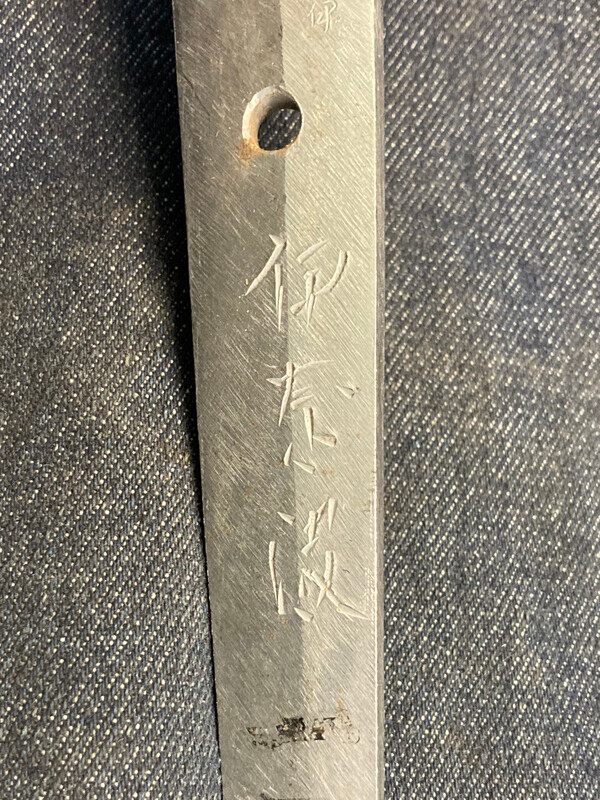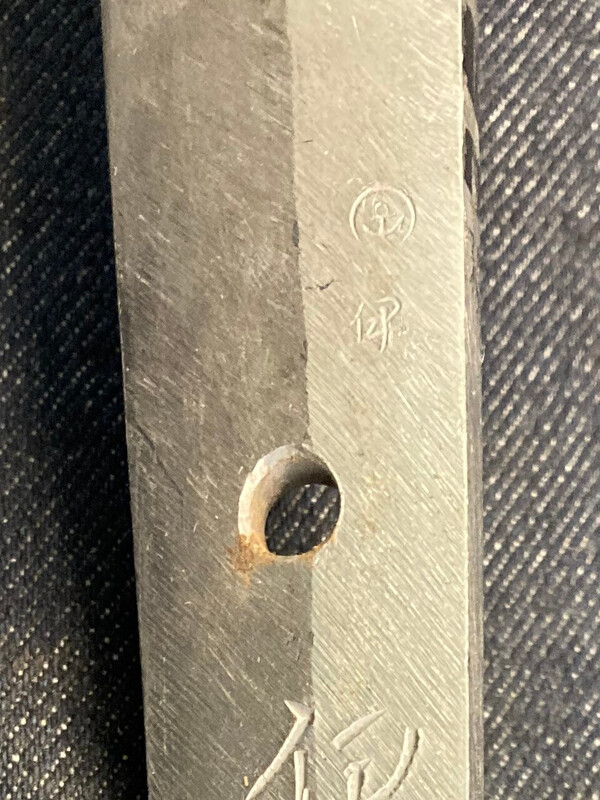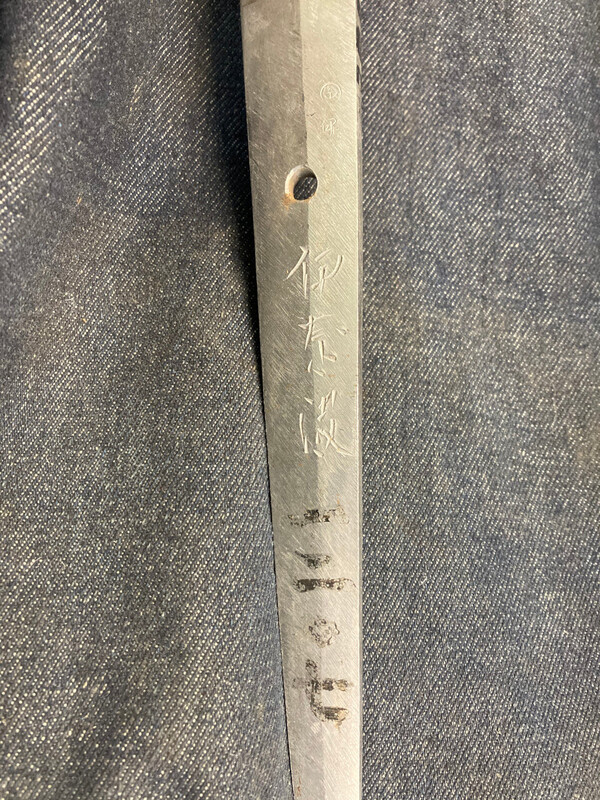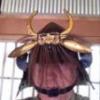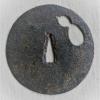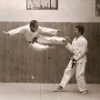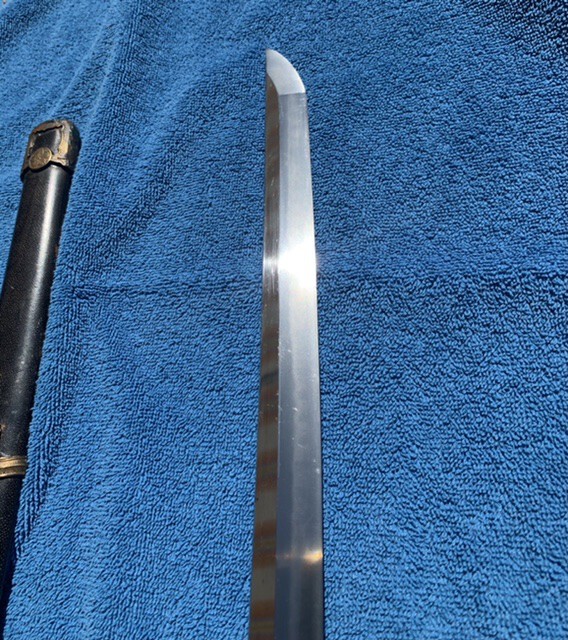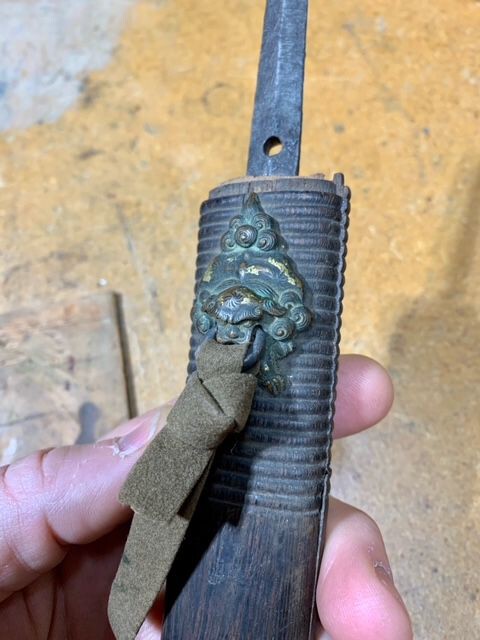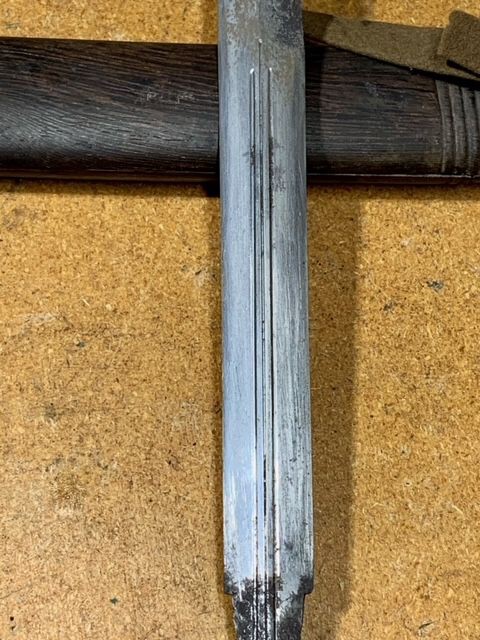Leaderboard
Popular Content
Showing content with the highest reputation on 05/10/2021 in all areas
-
Hello Everyone, it has been a while. A very recent development in my life has happened. I am going to become a father! Therefore need to sell some of my things for the future haha. I haven’t had much luck with the sale of this gorgeous Daisho yet, but have decided to lower the asking price to 10k aud. Please let me know if anyone is interested.4 points
-
As an alternative to the usual pairs of socks or sweater, I like to ensure at least one Christmas present is exciting to receive even though I have to buy it myself. Last Christmas my gift from me to me (how selfish can you get?) was this rather unusual tanto. As you can see, the blade is in the form of a leaf-shaped spear head. Although it has a typical yari habaki, in shakudo, I suspect it may have always been intended for a tanto as the signature 'Kanesaki saku' 兼先作 is just below the habaki, rather than further down what would normally be a yari tang. This appears to be the work of Mino Kanesaki, real name Heki Isuke, who worked around the end of the Muromachi period and later moved to Bizen. It is mounted with a hilt covered with rather distressed Dutch leather, and a saya decorated with dull, black lacquer swirls over polished black lacquer sprinkled with fine green abalone specks. There is a ko-kogatana with a brass blade, the hilt measuring only 8.5cm x 0.9cm in shibuichi decorated with a closed fan in silver. This is signed in soshu ?? and a kao.3 points
-
3 points
-
3 points
-
Michael's kanekuni is such a masterpiece(It's Hamon's craftiness that's outstanding!) that other kanekuni are no longer as good. Since kanekuni is a work that can easily be found in the market, you should carefully select a product that is as well-made as possible.3 points
-
hoshinamako.pdf Here three examples of unsigned hoshinamako-zu tsuba with NBTHK attribution to Shōami, Fukanobu and Yagyū (so you can choose...)3 points
-
3 points
-
One of the aspects that appeals to me about collecting pictorial tsuba is discovering what the design represents. Often the story behind the design eludes me for several years, as is the case of this example, which I hope is of interest. This small iron tsuba was evidently made for a wakizashi and depicts a samurai in full armour, holding a spear and gazing into the distance, while a peasant kneels at his feet. The samurai is standing below a pine tree and looking over an expanse of water, possible a sea. On the far side are two silver gilt triangles, the sails of two distant boats that the samurai looking at. On the reverse are two stoops of rice tipped with gold. The details on the tsuba are highlighted with gold, silver and copper inlay. The samurai, peasant and pine tree are all raised above the surface of the tsuba and appear to have been formed by hammering the body of the tsuba, as shown by the undulating surface, leaving proud areas which were then carved. The nakago ana has some long tegane at the top and bottom and a single kodzuka hitsu ana. Overall, the tsuba is in good condition, showing some wear to the gilding. It is mumei and I think it probably dates from the 19thC, possibly from the Shoami or Kaneie Myochin School. Other attributions welcome. A shakudo nanako tsuba with a similar design was offered for sale by AoiArt (F21022, https://www.aoijapan.com/tsubamumei-battle-of-fujito/) and was described as showing a scene from the battle of Fujito. According to Internet sources, the battle of Fujito, Kojima, Bizen Province took place on 7th December 1184 during the Gempei wars and is described in the Heike Monogatari. Taira forces (500 men) were holed up in a castle on Kojima under the command of Taira no Yukimori, effectively out of reach of the Minamoto forces. Sasaki Moritsuna asked a fisherman to show him a path through the shallows so that his men could cross to the island and attack the Taira. One version of the story says that Moritsuna was rewarded by being given large parts of the area around Kojima. The fisherman was not so lucky; Moritsuna killed him immediately after learning of the path to prevent the fisherman informing anyone of the plan of attack. I’ve also attached two prints; The first by Mizuno Toshikata shows Moritsuna asking the fisherman for directions. The second by Kuniyoshi shows Moritsuna’s horsemen crossing the sea, up to their necks in seawater. Another version of the crossing shows Moritsuna’s troops crossing on virtually dry land. In view of the fate of the poor fisherman I hope that the Kuniyoshi print is a more accurate depiction of the crossing and that Moritsuna had to fight in waterlogged armour and that his sword rusted from the seawater! I would guess that this tsuba was made for one of the ‘hoi polloi’, rather than a samurai, as the design hardly exemplifies the ‘samurai warrior ideal’, such as found on Soten tsuba; murdering a poor unarmed fisherman after he had been so helpful. Tsuba data: Height: 6.6 cm: Width: 6.0 cm: Thickness (rim): 0.3 cm: Weight: 62 g Best regards, John (Just a guy making observations, asking questions and trying to learn)2 points
-
Type 98 is good and looks promising, the "Type 94" is a Chinese replica.2 points
-
Hello Brano, If you are looking for the Japanese index, see attachment (I don't have an English translation sorry). Best NBTHK_24°Tokubetsu-Juyo_2016.pdf2 points
-
My first nihonto was a wakizashi blade in a stripped saya, no tsuka or tsuba, it cost 7 weeks pocket money, £4. 10 shillings.2 points
-
2 points
-
2 points
-
1 point
-
Hello my Nihonto friends! As my collection grows, I am seeking to lighten up my collection and let go of this beautiful set of daisho within my collection. This is a superb set of DAI-SHO by skillful sword smith the 25th generation Fujiwara KANEFUSA 二十五代藤原兼房. His real name is KATO Kazuo 加藤賀津雄 who was born in 1957, as a 2nd son of the 24th generation Fujiwara KANEFUSA 二十四代藤原兼房. At the age of 18, he started training in famed living National treasure Gassan Sadakazu 月山貞一. After years of diligent study, he became an official authorized sword maker in 1982 and then established his own atelier in 1984. The founder Kanefusa 兼房 who paralleled to KANESADA 兼定 or KANEMOTO 兼元 has flourished throughout Japan ever since Muromachi Koto period. This masterpiece set of DAI-SHO bears SOUSHU manner in mind, especially ardently admired by the work of Shizu-Sasburo KANEUJI 志津三郎兼氏 from late Kamakura to Nambukucho period. There are splendidly active with abundant activities of Nie and Nioi, vividly bright in extreme beauty. Among similar works, this set of DAI-SHO was made to order. Blade construction:Shinogi-zukuri, Iori-mune, Width of base is wide standing firmly on base and less degree of tapering from base to elongated large Kissaki. The shape is created in a brave and lively style which is widespread during the period of the Northern and Southern Warring States Period Forging(Hada): Forging pattern is conspicuous Itame-hada with an indication of some large Mokume and streaming Masame-ware appears mostly along boundary lines. The steel gives off sparkling martensite crystals of Ji-Nie against bluish steel of Jigane to generate long gleaming lines of Chikei over the Hiraji surface. Temper(Hamon): Hamon is martensite crystals of frosty Nie based with misty-Nioi where boundary area shines clear and bright along varied in shape and height, flamboyant lines such as large-Choji, Tadpole-Choji or Waist constricted Choji and so on. There works with intensive long lines of Sunagashi and thick lines of Kinsen or Inazuma. The entire quenching state is impressively clear and bright in full of Soushu-den tradition. Temper of tip(Boshi): Boshi forms flame Kaen with an indication of intensive Hakikake. Tang(Nakago): Both Nakago are UBU in original. One Mekugi-ana peg hole. Slanting left Sujikai filemark. Single-bevelled Ha- agari Kurijiri heel end. The signature in Hakiomote front is Fujiwara KANEFUSA-saku 藤原兼房作, To order of MITSUMASA-uji generations 為光将氏重代 in new line. The other side is chiselled with the date of year A highly Auspicious day, October, Dog, the 1st calendar sign of Heisei (1994) 為光将氏重代 平成甲戌年十月吉祥日. Gold plated Silver Habaki collar, preserved in Shira-Saya mountings. Recent polish/Condition scale: mint (using a scale of mint-excellent-very good-good-fair-poor) Note: I apologise for the real life photos as I am not very good at taking them but feel free to PM me to take some more. Asking Price: 13,000.00 Aud1 point
-
i stick with my original opinion. the type 98 may have an older blade it in1 point
-
It's bad enough that the purveyors of craptana/chinatana continue to spread ignorance and dilute the market.... now they're just engaging in willful STUPIDITY out of greed.1 point
-
Job well done. There were many aggressively priced items on Mark and Grey's table and others as a whole. I am glad I went just to get acquainted otherwise who knows what damage I would have done to my wallet after seeing few very very appealing and tempting examples John1 point
-
I think the Atakigiri that Christian mentioned eariler is Jūyō Bunkazai as the mountings are classified as such and the sword is attached to them (However it is the koshirae that has achieved the rank, not the sword). I think also the signifigance is also mostly due to the history associated with that particular sword not because of the smith in question that made the sword. Also to be noted that the sword signed Bishū Osafune Sukesada and Eishō 6 (1509) [Jūyō 28] is of very good craftsmanship and has very well preserved horimono. I was looking at the entry and I do not think they point it towards any specific Sukesada just note the period, but my Japanese is still too weak for good readings (I did not see any of the famous Sukesada names in the text entry). Like Jacques I do think David Pepin is perhaps too optimistic in his signature valuation guide. His #3 above average quality are in my opinion often very basic Sukesada signature styles.1 point
-
I remember I was trying to let Paul (SBG owner) know what seems to be wrong with this project but the response was not too notable. There was a thread of it in SBG forum when the project was released. I genuinely believe there would be a market (in the western world too) for modern Japanese blades made and fitted for martial arts sold at reasonable prices. Which is where I think they should have aimed for instead of many questionable items. If I remember correctly, there were actually few that I might consider as decent deals for modern swords. The antiques on the other hand...1 point
-
Just got in a Kai-gunto by Inaba. Didn't recognize it right away because the signature is really kinda messy compared to the last one we had, posted here: This one has the 伊 stamp under the anchor. I do not see any serial number on the blade. It's painted with 1 2 0 7, which matches all the fittings.1 point
-
I would side with MARK on this, without better pictures. At best the one on the left is suspect. However, better pictures might reveal some thing else.1 point
-
赤 Aka is Red 坂 Saka is slope or slanting land, like in Osaka, (Big Slope) So Akasaka is 'Red Slope'. PS Not to be confused with Asakusa.1 point
-
Björn, it is indeed AKASAKA ( 元赤) (not Akasuka), and probably TADATOKI, fourth generation (died 1746). In my opinion, this is a nice TSUBA which I would like to own as well! As a plus, it has a good size (81,7 mm) and is in good condition. It seems to be sold out of Japan, so the question arises why it has no papers. If it were an authentic signed TADATOKI TSUBA, I think it would cost much more than 15.500 YEN.1 point
-
This matter (mei) has been discussed several times. There is one sword signed « Bishu Osafune Sukesada » which achieved Juyo.1 point
-
I would bet it is not hand forged. That's just a Showato. You dodged a bullet.1 point
-
Hello Chris, what other information did you receive? I think Piers gave you the right kanji and translation. I also think he's probably right about the connection to Banzaishi Moritoshi (early 1800s). Same kanji in the swordsmith name, similar geographic location, similar use of the "banzai" phrase. There aren't many Moritoshi smiths in the swordsmith indexes - actually, just this one in Markus Sesko's compilation. So I think this is your man. Don't try to clean it up or scrape the rust off. If possible, get it into the hands of someone who knows Japanese swords. Yours is in bad shape, but it may be salvageable if it gets professional treatment . Resist the urge to do any amateur restoration work. At most, give it gentle wipe with lightweight oil.1 point
-
1 point
-
They are showing all the old Columbo series on TV. I love seeing the cars, the fashions, and the dollar prices, reminding me of my college days.1 point
-
Greetings, I am new and found this forum while trying to research a WWII Japanese sword. I have the opportunity to purchase the sword pictured below. This would be my first Japanese sword. Thank you in advance for anyone willing to help out a newbie with information and advice. Is it real? Is it traditionally made?Is it old? What is the value? It is a WWII vet bring back according to the vet's son. Let me know if more photos are needed.1 point
-
1 point
-
Hi Scott, this is a very nice example and rare for a sword made during the war to have bohi grooves in the blade. Many collectors would be happy to have such a nice example in their collection, so if the price is not outrageous I say buy it quick! Make sure to gather as much information from the son about his father and how he acquired the sword.1 point
-
1 point
-
That sword is dated Heisei 13 (2001), 5 years before he was granted Mukansa, I think he did a good job with it.1 point
-
Guys, PLEASE stop quoting when you are the next reply. It clutters everything. Just reply. Not quote.1 point
-
I bought a Yokoyama Bizen Sukenaga wakizashi with kiku and ichi that was out of polish, a very early (I think kamakura or early nambokucho, but others think later) cut down osuriage katana and a Dewa Gassan wakizashi with papers that had koshirae (this one was for a friend). I sold two blades as well and handed the rest of the blades that I brought to Andy Quirt, so you may see them on his site over the next few months. It was nice to attend and I am so grateful to Mark Jones for putting it on.1 point
-
I’m not sure it’s such a good idea too keep linking to his monetized videos: people get paid for every click so giving him views, hate views even, will encourage that idiot and help him buy more victims. It’s the same dilemma as when friends warn me about YouTube videos where people mistreat animals, as much as an outrage that is, unless you’re going to brigade to report those videos for tos violations (even if they might not technically be violating tos) so that they get demonetized, nothing will be gained by giving those bad people exposure. Granted destroying a fine sword isn’t quite as bad but I still think it better the guy doing this remain obscure.1 point
This leaderboard is set to Johannesburg/GMT+02:00


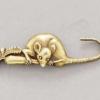

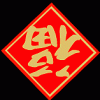
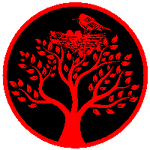
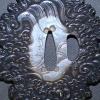





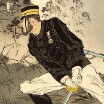

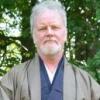
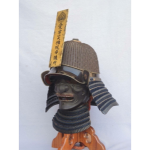


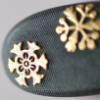
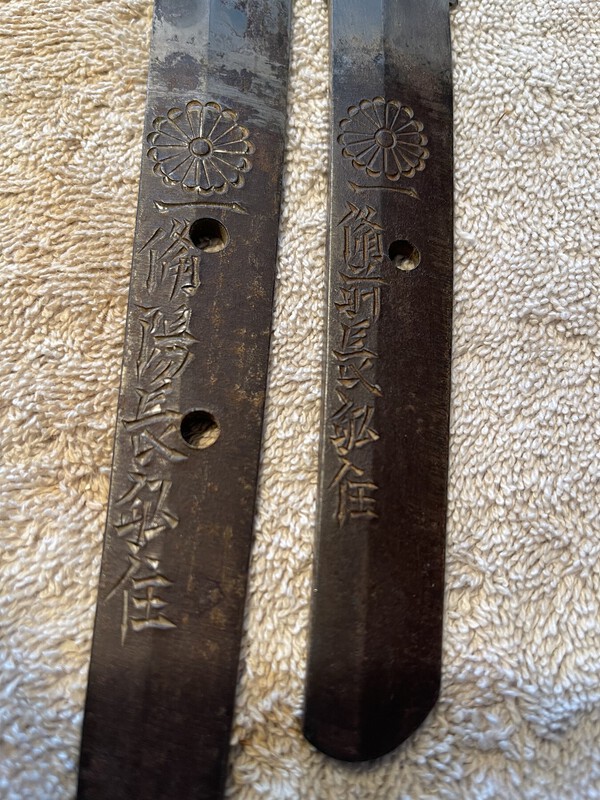



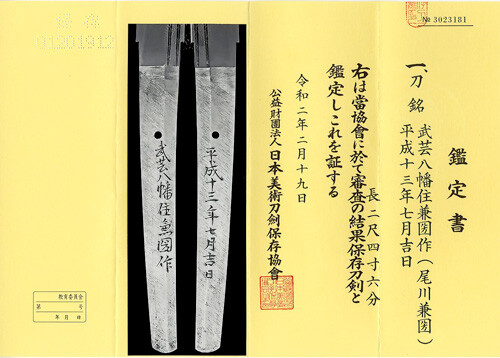




.thumb.jpg.e63b3dcc8d335658069db3ef7b1ff412.jpg)
.thumb.jpg.43c2b7ec572f6cc03566e4bcbf14ed76.jpg)



